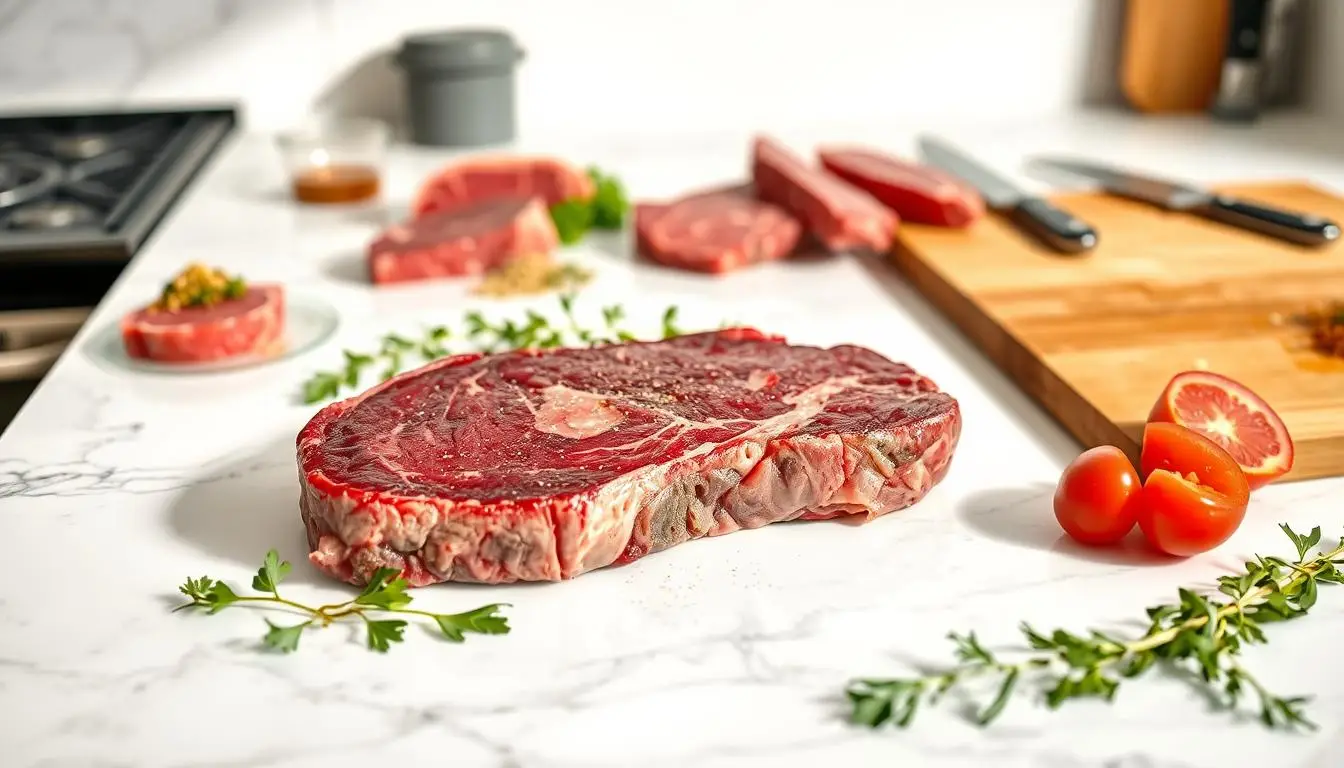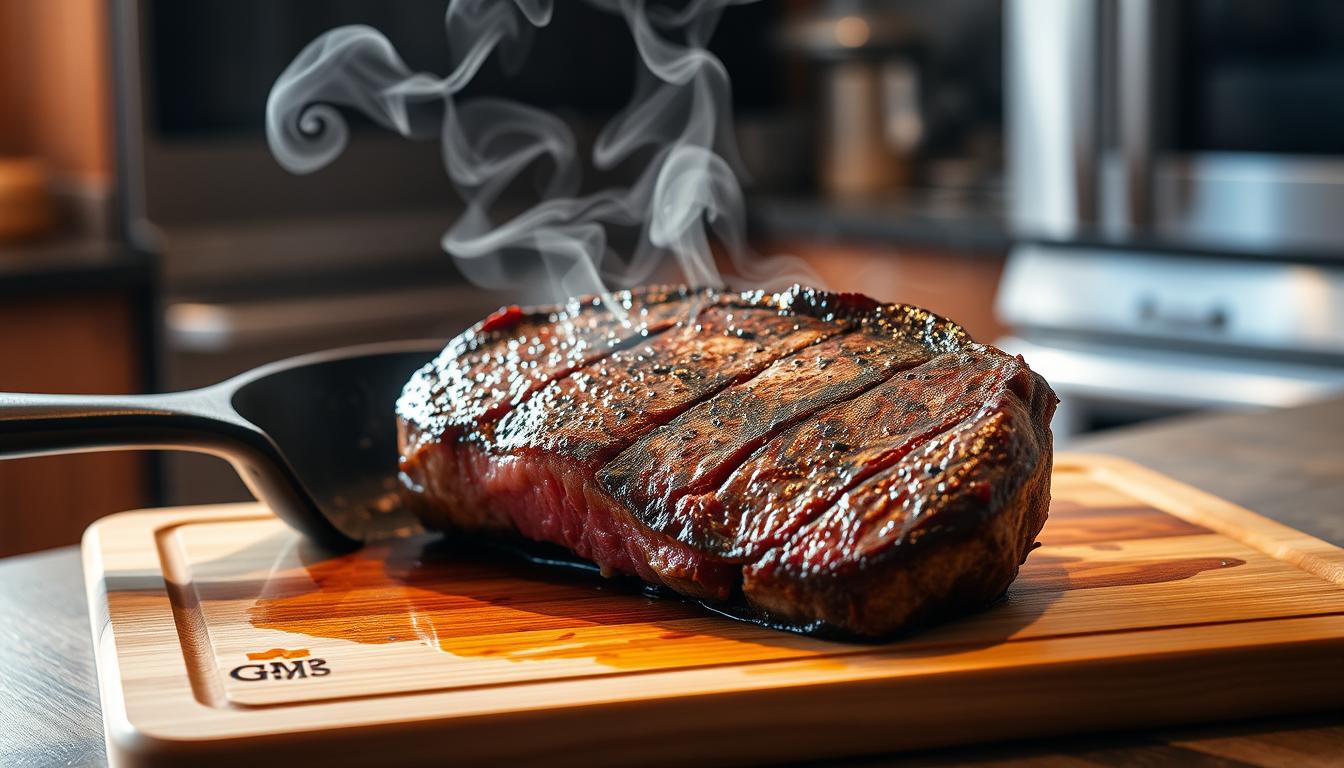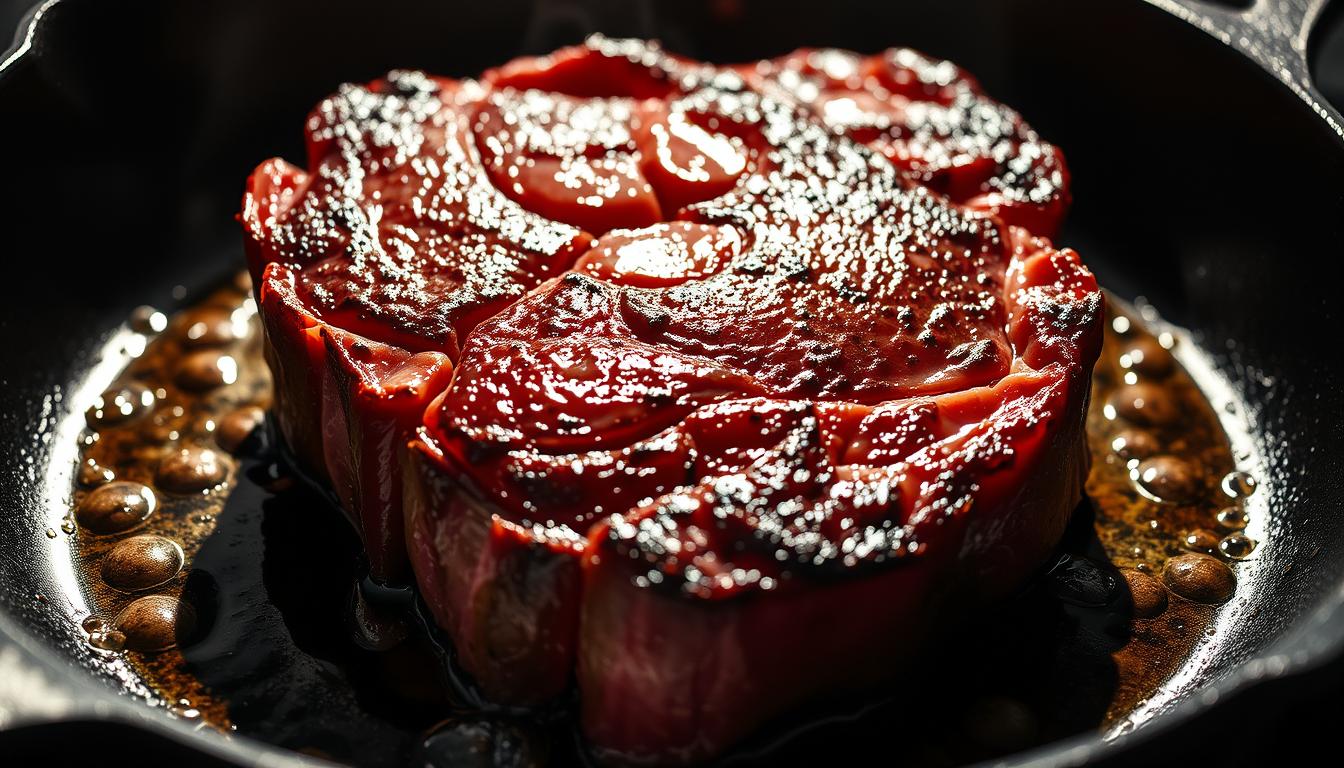How to Cook the Perfect 10 oz Steak at Home in 2025

How to Cook the Perfect 10 oz Steak at Home in 2025
Table of Contents

Imagine turning your kitchen into a fancy steakhouse. Every 10 oz steak comes out perfectly cooked, with a golden crust and tender meat. Cooking steaks like a pro at home is an art that mixes passion, precision, and skill.
By 2025, cooking at home has changed a lot. Now, food lovers have more control over making amazing ribeye and filet mignon. Whether you cook on weekends or seriously, learning to cook the perfect 10 oz steak will make your dishes stand out. It will impress even the pickiest of guests.
This guide will show you how to prepare steaks perfectly. You’ll learn about choosing the best cuts and cooking techniques. These will help you bring out the best flavors and textures in your steaks.
Ingredients :
- 1 (10 oz) beef ribeye steak (about 1-inch thick)
- 1 tablespoon olive oil
- 1 tablespoon unsalted butter
- 2 cloves garlic, minced
- 1 teaspoon kosher salt
- 1/2 teaspoon freshly ground black pepper
- 1 sprig fresh rosemary (optional)
Directions:
Let the 10 oz steak sit at room temperature for about 30 minutes before cooking. This helps ensure even cooking.
Pat the steak dry with paper towels to remove excess moisture. Season both sides generously with kosher salt and black pepper.
In a heavy skillet or cast iron pan, heat the olive oil over medium-high heat until shimmering but not smoking.
Place the steak in the pan and cook without moving it for about 3 to 4 minutes, allowing a golden crust to form.
Flip the steak and cook for another 3 minutes for medium-rare, or adjust the time to your desired doneness. Use a meat thermometer if needed (130°F for medium-rare).
In the last minute of cooking, add the butter, minced garlic, and rosemary sprig to the pan. Tilt the pan slightly and spoon the melted butter and garlic over the steak repeatedly.
Remove the steak from the skillet and let it rest on a cutting board for 5 minutes. This step is important to retain the juices.
Slice against the grain and serve with the garlic butter spooned over the top.
Servings: 1
Calories: 680
Nutritional Information:
- Calories: 680
- Protein: 48g
- Fat: 52g
- Carbohydrates: 1g
Key Takeaways
- Learn professional techniques for cooking 10 oz steak at home
- Understand different steak cuts and their unique characteristics
- Master temperature control for perfect doneness
- Discover advanced seasoning and marinading strategies
- Create restaurant-quality results in your own kitchen
Understanding Different Types of 10 oz Steak Cuts
Choosing the right steak can make your meal special. Each cut has its own taste, texture, and look. Knowing the differences helps you pick the perfect steak for your next meal.
Ribeye vs Filet Mignon: Making the Right Choice
The 10 oz ribeye steak is known for its rich flavor and marbling. On the other hand, the beef tenderloin (filet mignon) is leaner and more delicate. Your choice depends on what you like:
- Ribeye: Intense beef flavor, higher fat content
- Filet Mignon: Extremely tender, mild flavor
USDA Grades and Their Impact on Quality
USDA grading shows the meat’s quality. It looks at marbling, age, and muscle development. Here’s a quick guide:
| USDA Grade | Marbling | Tenderness |
|---|---|---|
| Prime | Abundant | Highest |
| Choice | Moderate | Good |
| Select | Minimal | Least tender |
Premium vs Budget Cuts: What You Need to Know
Steaks vary in quality and price. Porterhouse steak is luxurious, while sirloin is more affordable. Think about these when choosing:
- Budget constraints
- Flavor profile desired
- Cooking method
- Nutritional preferences
Pro tip: For the best value, look for cuts with good marbling that match your cooking skills and flavor preferences.
Essential Tools and Equipment for Steak Preparation
Getting the perfect grilled steak is more than just using great meat. The right tools can make a big difference. They help you cook better and improve your skills.
Every steak preparation toolkit needs a few key items. A top-notch meat thermometer is key for the perfect doneness. Cast-iron skillets also help, giving that perfect sear you see in restaurants.
- High-carbon stainless steel chef’s knife
- Digital instant-read meat thermometer
- Heavy-duty cast-iron skillet
- Reliable tongs with heat-resistant handles
- Quality cutting board with non-slip surface
Professional chefs say choose tools that last and are precise. Grilled steak preparation is an art that requires the right equipment.
| Tool | Purpose | Recommended Investment |
|---|---|---|
| Chef’s Knife | Precise meat trimming | $100-$250 |
| Meat Thermometer | Temperature accuracy | $50-$150 |
| Cast-Iron Skillet | Perfect searing | $30-$100 |
Choosing top-quality tools will take your home grilled steak game to the next level.
The Science Behind Perfect Steak Temperature
Cooking a 10 oz ribeye needs precision and knowledge of meat science. Getting the temperature right is key to a great steak. It turns a good steak into a memorable meal.
Mastering steak temperature is more than just heat. It’s about how cooking changes the meat’s structure. It also affects the flavor and texture.
Understanding Meat Thermometers
A good meat thermometer is essential for cooking steak. Digital instant-read thermometers give the most accurate readings. They help you check the steak’s doneness perfectly.
- Choose a digital instant-read thermometer
- Insert the probe into the thickest part of the meat
- Avoid touching bone or fat for accurate readings
Temperature Guide for Different Doneness Levels
| Doneness | Internal Temperature | Meat Appearance |
|---|---|---|
| Rare | 125°F | Cool red center |
| Medium Rare | 135°F | Warm red center |
| Medium | 145°F | Pink center |
| Medium Well | 150°F | Slight pink center |
| Well Done | 160°F | No pink |
Resting Time and Temperature Control
Let your steak rest for 5-10 minutes after cooking. This step helps the juices spread, making the steak tender and flavorful. The temperature will rise a bit, so remove it just before it reaches your desired level.
Remember, precise temperature makes a steak go from ordinary to extraordinary.
Preparing Your 10 oz Steak Before Cooking
Getting your 10 oz ribeye ready for cooking is key. The right steps can make your steak truly special. It ensures great flavor and keeps the 10 oz ribeye nutrition top-notch.
First, take your steak out of the fridge 30-45 minutes before cooking. This lets it warm up to room temperature. This step helps it cook evenly and reach the perfect doneness.
- Pat the steak dry with paper towels to remove excess moisture
- Trim excess fat if needed, leaving a thin layer for flavor
- Inspect the meat for any unusual discoloration or texture
Nutritional prep is also crucial. A 10 oz ribeye is packed with protein. It’s great for building muscle and boosting nutrition.
| Nutrient | Amount per 10 oz Ribeye |
|---|---|
| Protein | 52-56 grams |
| Total Fat | 30-35 grams |
| Calories | 550-600 |
“Proper preparation is the secret to a restaurant-quality steak at home.” – Professional Chef Michael Roberts
By following these steps, you’ll get a perfectly cooked, nutritious 10 oz ribeye. It will wow any steak lover.
Ultimate Steak Marinade Recipes for Enhanced Flavor
Turning a simple steak into a masterpiece starts with the right marinade. Marinades do more than add flavor; they also tenderize the meat. The perfect mix can make a 10 oz steak taste like it’s from a fancy restaurant.
Marinating is an art that needs the right mix of ingredients. A top marinade has three main parts:
- Acid (like vinegar or citrus juice)
- Oil (to help distribute flavors)
- Seasonings (herbs and spices)
Classic Garlic and Herb Marinade
For a classic marinade, mix minced garlic, fresh rosemary, thyme, olive oil, and balsamic vinegar. This combo is perfect for ribeye and New York strip, adding rich flavors to every bite.
Asian-Inspired Soy-Ginger Blend
Make an Asian-style marinade with soy sauce, ginger, sesame oil, and honey. This mix offers a great balance of umami and sweetness, perfect for lean cuts like filet mignon.
Wine-Based Marinades for Rich Taste
Red wine is great for a fancy marinade. Mix it with shallots, black pepper, and herbs. This marinade tenderizes and boosts your steak’s natural taste.
Remember, marinate in the fridge and don’t go over 2-4 hours. The right marinade can take your cooking to the next level.
Modern Cooking Methods for the Perfect Steak

Cooking the perfect grilled steak has changed a lot in recent years. Now, home chefs have many ways to make a 10 oz steak taste like it’s from a fancy restaurant. Learning these new cooking methods can make your steak go from good to amazing.
Let’s look at the latest ways to cook a tasty steak:
- Sous Vide Method: This method seals your steak in a bag and cooks it in water at a set temperature. It makes sure the steak is cooked evenly and stays juicy.
- Reverse Searing: First, cook the steak in a cool oven. Then, sear it quickly over high heat to get a great crust.
- High-Heat Grilling: The classic way to grill a steak. It gives the steak a nice char and lots of flavor.
Choosing how to cook your steak depends on what you have and what you want. Sous vide ensures the steak is cooked perfectly, while reverse searing lets you control the meat’s temperature.
Here are some modern tips for grilling steak:
- Get a good meat thermometer
- Try different heat sources
- Let the steak rest after cooking
Technology has made cooking steak at home easier. Whether you like traditional grilling or new methods, learning these techniques will help you make the perfect steak every time.
Mastering the Art of Steak Seasoning
Seasoning turns a simple 10 oz steak into a culinary masterpiece. The right seasoning can boost the meat’s flavor and make your meal unforgettable. It’s key for home cooks to master seasoning to get restaurant-quality results.
Your 10 oz steak needs careful preparation. Salt is essential for enhancing the meat’s natural taste and creating a great crust. Professional chefs share several techniques to improve taste and texture.
Salt Timing and Techniques
Salting your steak is all about timing. Different methods can greatly affect the outcome:
- Dry brining: Salt the 10 oz steak 40 minutes before cooking
- Quick salting: Season immediately before cooking for a crisp exterior
- Advanced technique: Salt up to 24 hours in advance for deep flavor penetration
Specialty Rubs and Blends
Creating unique flavors lets you customize your 10 oz steak. Try these exciting rub combinations:
- Smoky Paprika Blend: Combines smoked paprika, garlic powder, and black pepper
- Herb-Infused Mix: Rosemary, thyme, and dried oregano with sea salt
- Spicy Southwest Rub: Chili powder, cumin, and cayenne for heat lovers
Pro tip: Always apply dry rubs generously and pat them into the meat’s surface for maximum flavor absorption.
Remember, seasoning is an art. Your 10 oz steak will appreciate the effort you put into enhancing its flavor.
How to Achieve Restaurant-Quality Sear at Home

Getting a perfect sear on your 10 oz ribeye steak makes your meal special. It turns it into something you’d find in a restaurant. The secret is knowing a few key techniques that chefs use.
First, pick the right cooking surface. Cast iron skillets are the best for a great sear. They keep heat well and spread it evenly, making the steak brown beautifully.
- Make sure your skillet is very hot before adding the steak
- Pat the steak dry to help it brown better
- Use oils that don’t burn easily, like avocado or grapeseed
The Maillard reaction is what makes a perfect sear. It happens when meat proteins and sugars react at high heat. This creates flavors that make your steak taste rich and deep.
“A great sear is the difference between a good steak and an unforgettable dining experience.” – Professional Chef
| Searing Technique | Temperature Range | Cooking Duration |
|---|---|---|
| High Heat Sear | 450-500°F | 2-3 minutes per side |
| Medium-High Heat | 400-450°F | 3-4 minutes per side |
Pro tip: Don’t move your 10 oz ribeye steak around in the pan. Let it sit still to get a beautiful crust. This way, you’ll get a sear that looks like it was done by a pro.
Pairing Your Steak with Premium Sauces
Improving your 10 oz steak experience is more than just cooking it right. The right sauce can turn a good meal into a memorable one. It’s all about picking a sauce that matches your steak’s flavor.
Choosing the right sauce is key. It should make your steak taste even better, not hide its flavor. Chefs say to match the sauce’s strength with the steak’s.
Classic Béarnaise Sauce Mastery
Béarnaise sauce is the top choice for steak lovers. It’s a French classic that needs the right ingredients and skill:
- Fresh tarragon leaves
- High-quality butter
- Egg yolks
- White wine vinegar
- Shallots
Modern Steak Sauce Innovations
New steak sauce flavors are exciting. From smoky chipotle to red wine reduction, they mix things up.
| Sauce Type | Flavor Profile | Best Steak Pairing |
|---|---|---|
| Chimichurri | Herbaceous, Tangy | Ribeye |
| Peppercorn | Spicy, Rich | New York Strip |
| Red Wine Reduction | Complex, Elegant | Filet Mignon |
Try out different sauces to find your favorite. The goal is to enhance your steak, not overshadow it.
Side Dishes That Complement Your 10 oz Steak
Choosing the right side dishes can make your 10 oz ribeye a memorable meal. It’s all about finding a balance that matches the steak’s rich flavors. This balance is key to a well-rounded plate.
When thinking about 10 oz ribeye nutrition, pair your steak with sides that add nutrients and flavors. It’s important to mix vegetables, starches, and lighter options. This way, you get a balanced meal.
- Roasted Vegetable Medley: A colorful mix of seasonal vegetables
- Garlic Mashed Potatoes: Creamy and rich side dish
- Grilled Asparagus: Light and nutritious green option
- Quinoa Salad: Protein-packed alternative to traditional sides
Your 10 oz ribeye is packed with protein and essential nutrients. The right sides can boost both taste and nutrition.
| Side Dish | Calories | Protein (g) |
|---|---|---|
| Roasted Brussels Sprouts | 70 | 4 |
| Garlic Mashed Potatoes | 250 | 5 |
| Quinoa Salad | 180 | 8 |
“A great side dish should complement, not compete with, your main course.” – Professional Chef
Remember, variety is the spice of life. Try different side dishes to find your favorite mix. This keeps your meals interesting and healthy.
Wine and Beverage Pairing Guidelines
Improving your ribeye steak experience is more than just cooking it right. It’s about making a complete dining adventure with the right drinks. The perfect drink can turn a great meal into an unforgettable experience.
Finding the best wine for your ribeye steak involves some key principles. Your choice should match the meat’s rich taste and bring out its best qualities.
Red Wine Selection Tips
Here are some important tips for pairing wine with ribeye steak:
- Choose full-bodied red wines with strong tannins
- Look for wines with high acidity to balance the steak’s richness
- Prioritize wines from regions known for bold red varieties
Here are some top red wine choices:
- Cabernet Sauvignon – A classic choice with intense flavor
- Malbec – Smooth texture that pairs well with ribeye steak
- Syrah/Shiraz – A powerful wine that matches the meat’s boldness
Alternative Beverage Options
Not into wine? No worries. Craft beers, bourbon, and even fancy mocktails can be great with your ribeye steak.
“The perfect beverage doesn’t just accompany a meal—it elevates the entire dining experience.”
Try different pairings to find what you like best. This way, you can make your dining moments truly special.
Common Steak Cooking Mistakes to Avoid
Cooking a perfect 10 oz steak needs skill and focus. Many home cooks make mistakes that ruin a great grilled steak. Knowing these common errors can help you cook like a pro.
- Temperature Misjudgment: Not knowing the right meat temperature is a big mistake. A 10 oz steak needs careful heat control.
- Improper Preparation: Skipping steps like letting the steak warm up can cause uneven cooking.
- Overcrowding the Cooking Surface: Too many steaks in the pan stop proper searing and heat spread.
Grilled steak lovers often struggle with getting the perfect sear. Here’s how to avoid common mistakes:
- Never start with a cold pan or grill
- Don’t move the steak too much
- Always let the steak rest after cooking
Keeping the temperature right is key for a perfect 10 oz steak. Here’s a quick guide for cooking temperatures:
| Doneness Level | Internal Temperature | Cooking Time |
|---|---|---|
| Rare | 125°F | 3-4 minutes per side |
| Medium Rare | 135°F | 4-5 minutes per side |
| Medium | 145°F | 5-6 minutes per side |
Avoiding these common mistakes can make your 10 oz steak amazing. Remember, the more you practice, the better you’ll get at grilling steak.
Nutritional Information and Health Considerations
Knowing what’s in a 10 oz ribeye steak is key to smart eating. It has about 600-700 calories, making it a big protein source for meat fans. Most of these calories come from protein and fat, which are good for muscles.
The protein in a 10 oz ribeye is really high. You’ll get around 50-60 grams of top-quality protein in one serving. This is great for keeping muscle or helping with fitness goals.
- Calories in a 10 ounce ribeye: 600-700
- Protein content: 50-60 grams
- Key nutrients: Iron, zinc, vitamin B12
- Fat content: Approximately 40-50 grams
There’s more to think about than just calories and protein. Ribeye steaks also have important nutrients for health. Zinc boosts immune function, and vitamin B12 is good for nerves and blood cells. Iron in beef helps fight anemia.
A balanced approach to consuming steak involves moderation and mindful preparation.
How you cook your steak matters for its nutrition. Grilling or broiling lets fat drip off, cutting calories. Adding veggies to your meal makes it healthier and more nutritious.
Even though ribeye is nutritious, watch your portion size and how often you eat it. Talking to a nutritionist can help you enjoy this tasty cut in a healthy way.
Conclusion
Cooking the perfect 10 oz steak is an art that needs skill, passion, and precision. Your journey starts with picking the right meat, preparing it, and choosing how to cook it. Each step is important to make a meal as good as a restaurant’s.
Remember, getting better at cooking steak takes practice. Try different marinades, seasonings, and cooking ways to find your style. Like professional chefs, you’ll get better with each try and learn how to make great steak.
For more tips and top-notch beef, check out beefsalami.com. They offer great recipes, cooking advice, and quality beef. With the right knowledge, you’ll impress everyone with your steak dishes.
Your steak adventure is about trying new things, enjoying the process, and making unforgettable meals. Trust yourself, enjoy every step, and become a master of cooking steak at home.
FAQ
How many calories are in a 10 oz ribeye steak?
A 10 oz ribeye steak has about 600-700 calories. This number changes based on the steak’s fat content and cut. Grilled or pan-seared steaks have slightly different calorie counts.
What is the protein content of a 10 oz ribeye?
A 10 oz ribeye steak has about 60-70 grams of protein. It’s a great source of high-quality protein. This is good for building muscle, recovery, and a balanced diet.
What’s the best way to cook a 10 oz ribeye steak?
First, let the steak come to room temperature. Then, sear it in a hot skillet or grill. Finish it in the oven for the perfect doneness. For medium-rare, aim for 130-135°F.
How long should I let my steak rest after cooking?
Let your steak rest for 5-10 minutes after cooking. This lets the juices spread evenly, making the steak tender and flavorful. Cover it loosely with foil to keep it warm.
What’s the difference between ribeye and filet mignon?
Ribeye is more marbled and flavorful, with more fat. Filet mignon is leaner and tender. Ribeye comes from the rib section and has a stronger beef flavor. Filet mignon is from the tenderloin and is pricier.
What are the USDA beef grades?
The USDA grades beef as Prime, Choice, and Select. Prime has lots of marbling and is the highest quality. Choice is high quality with moderate marbling. Select is leaner with less marbling.
How do I choose the right steak at the store?
Look for steaks with consistent marbling, a bright red color, and firm texture. Check the package date and choose steaks with minimal excess liquid. Opt for cuts with white fat, not yellow. More marbling in ribeye means more flavor and tenderness.
What are the best marinades for a ribeye steak?
Classic marinades include garlic and herb blends, soy-ginger mixtures, and wine-based options. A simple mix of olive oil, garlic, rosemary, and black pepper works well. It enhances the steak’s natural flavors without overpowering it.
How can I ensure my steak is cooked to the right temperature?
Use a reliable meat thermometer to check the internal temperature. For medium-rare, aim for 130-135°F. Medium is 140-145°F, and medium-well is 150-155°F. Always let the steak rest after cooking to stabilize the temperature.
What side dishes pair well with a ribeye steak?
Classic steakhouse sides include roasted vegetables, garlic mashed potatoes, creamed spinach, and crispy Brussels sprouts. For a lighter option, try a fresh salad or grilled asparagus. These complement the rich flavor of the ribeye.

oiovay
самоклеющаяся пленка для наружных работ [url=https://www.samokleyushchayasya-plenka-1.ru]самоклеющаяся пленка для наружных работ[/url] .
элитная дизайнерская мебель санкт-петербург [url=http://www.dizajnerskaya-mebel-1.ru]элитная дизайнерская мебель санкт-петербург[/url] .
установить кондиционер в обнинске цена [url=http://kondicioner-obninsk-1.ru/]установить кондиционер в обнинске цена[/url] .
производство натяжных потолков [url=natyazhnye-potolki-lipeck-1.ru]производство натяжных потолков[/url] .